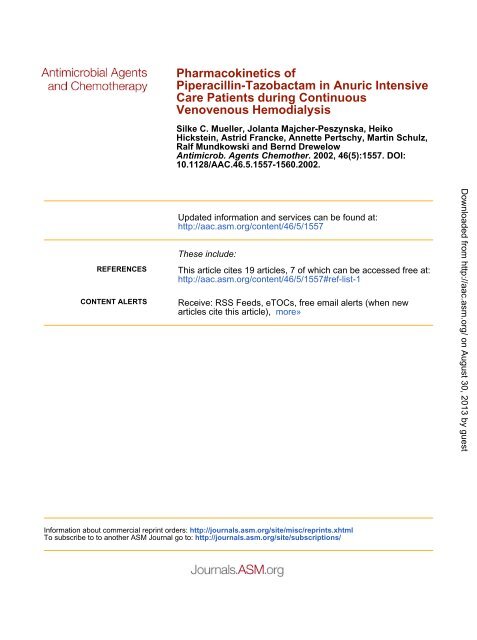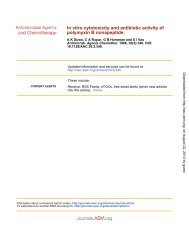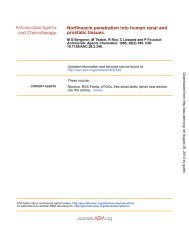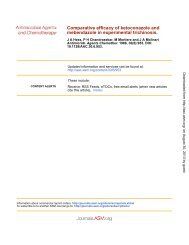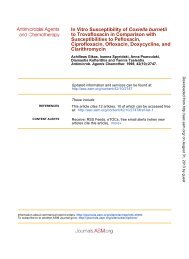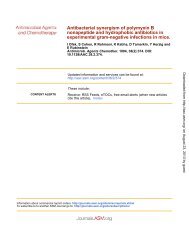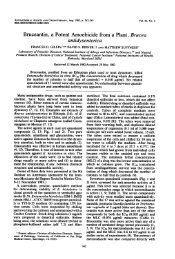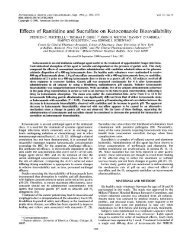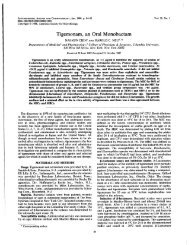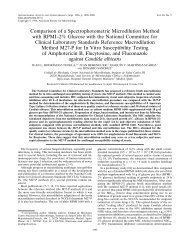Pharmacokinetics of Piperacillin-Tazobactam in Anuric Intensive ...
Pharmacokinetics of Piperacillin-Tazobactam in Anuric Intensive ...
Pharmacokinetics of Piperacillin-Tazobactam in Anuric Intensive ...
Create successful ePaper yourself
Turn your PDF publications into a flip-book with our unique Google optimized e-Paper software.
<strong>Pharmacok<strong>in</strong>etics</strong> <strong>of</strong><br />
<strong>Piperacill<strong>in</strong></strong>-<strong>Tazobactam</strong> <strong>in</strong> <strong>Anuric</strong> <strong>Intensive</strong><br />
Care Patients dur<strong>in</strong>g Cont<strong>in</strong>uous<br />
Venovenous Hemodialysis<br />
Silke C. Mueller, Jolanta Majcher-Peszynska, Heiko<br />
Hickste<strong>in</strong>, Astrid Francke, Annette Pertschy, Mart<strong>in</strong> Schulz,<br />
Ralf Mundkowski and Bernd Drewelow<br />
Antimicrob. Agents Chemother. 2002, 46(5):1557. DOI:<br />
10.1128/AAC.46.5.1557-1560.2002.<br />
REFERENCES<br />
CONTENT ALERTS<br />
Updated <strong>in</strong>formation and services can be found at:<br />
http://aac.asm.org/content/46/5/1557<br />
These <strong>in</strong>clude:<br />
This article cites 19 articles, 7 <strong>of</strong> which can be accessed free at:<br />
http://aac.asm.org/content/46/5/1557#ref-list-1<br />
Receive: RSS Feeds, eTOCs, free email alerts (when new<br />
articles cite this article), more»<br />
Downloaded from http://aac.asm.org/<br />
on August 30, 2013 by guest<br />
Information about commercial repr<strong>in</strong>t orders: http://journals.asm.org/site/misc/repr<strong>in</strong>ts.xhtml<br />
To subscribe to to another ASM Journal go to: http://journals.asm.org/site/subscriptions/
ANTIMICROBIAL AGENTS AND CHEMOTHERAPY, May 2002, p. 1557–1560 Vol. 46, No. 5<br />
0066-4804/02/$04.000 DOI: 10.1128/AAC.46.5.1557–1560.2002<br />
Copyright © 2002, American Society for Microbiology. All Rights Reserved.<br />
<strong>Pharmacok<strong>in</strong>etics</strong> <strong>of</strong> <strong>Piperacill<strong>in</strong></strong>-<strong>Tazobactam</strong> <strong>in</strong> <strong>Anuric</strong> <strong>Intensive</strong> Care<br />
Patients dur<strong>in</strong>g Cont<strong>in</strong>uous Venovenous Hemodialysis<br />
Silke C. Mueller, 1 * Jolanta Majcher-Peszynska, 1 Heiko Hickste<strong>in</strong>, 2 Astrid Francke, 3 Annette Pertschy, 4<br />
Mart<strong>in</strong> Schulz, 2 Ralf Mundkowski, 1 and Bernd Drewelow 1<br />
Department <strong>of</strong> Cl<strong>in</strong>ical Pharmacology, Institute <strong>of</strong> Experimental and Cl<strong>in</strong>ical Pharmacology and Toxicology, 1 Cl<strong>in</strong>ic for Internal<br />
Medic<strong>in</strong>e, 2 Cl<strong>in</strong>ic for Anesthesiology and <strong>Intensive</strong> Care Medic<strong>in</strong>e, 3 and Cl<strong>in</strong>ic for Surgery, 4<br />
University <strong>of</strong> Rostock, D-18057 Rostock, Germany<br />
Received 16 January 2001/Returned for modification 15 July 2001/Accepted 25 January 2002<br />
The pharmacok<strong>in</strong>etics <strong>of</strong> piperacill<strong>in</strong>-tazobactam were <strong>in</strong>vestigated <strong>in</strong> eight anuric <strong>in</strong>tensive care patients<br />
treated by cont<strong>in</strong>uous venovenous hemodialysis (CVVHD). The elim<strong>in</strong>ation half-life <strong>of</strong> piperacill<strong>in</strong> was 4.3 <br />
1.2 h, and that <strong>of</strong> tazobactam was 5.6 1.3 h. The contribution <strong>of</strong> CVVHD to the overall elim<strong>in</strong>ation was<br />
relevant (>25%) for both drugs.<br />
<strong>Piperacill<strong>in</strong></strong>-tazobactam is a -lactam–-lactamase <strong>in</strong>hibitor<br />
comb<strong>in</strong>ation with a broad spectrum <strong>of</strong> antibacterial activity<br />
aga<strong>in</strong>st gram-positive as well as gram-negative pathogens. It is<br />
frequently used for the empirical treatment <strong>of</strong> <strong>in</strong>fection <strong>in</strong><br />
<strong>in</strong>tensive care patients (2, 15). The aim <strong>of</strong> this <strong>in</strong>vestigation was<br />
to determ<strong>in</strong>e the pharmacok<strong>in</strong>etics <strong>of</strong> piperacill<strong>in</strong>-tazobactam<br />
<strong>in</strong> critically ill patients with acute anuric renal failure treated by<br />
cont<strong>in</strong>uous venovenous hemodialysis (CVVHD).<br />
Eight critically ill patients were <strong>in</strong>cluded <strong>in</strong> the <strong>in</strong>vestigation<br />
(Table 1). Inclusion criteria were an age <strong>of</strong> 18 years, acute renal<br />
failure treated by CVVHD, anuria (100 ml <strong>of</strong> ur<strong>in</strong>e/day), and<br />
treatment with piperacill<strong>in</strong>-tazobactam. Patients with severe liver<br />
failure or cholestasis were excluded. The protocol <strong>of</strong> the study was<br />
approved by the local ethical committee, and <strong>in</strong>formed consent<br />
was obta<strong>in</strong>ed from a first-degree relative. CVVHD was performed<br />
with an AN69 hollow-fiber dialyzer (Multiflow 60; Hospal,<br />
Nuremberg, Germany) under the follow<strong>in</strong>g conditions: a<br />
blood flow rate <strong>of</strong> 150 ml/m<strong>in</strong>, a dialysate flow rate <strong>of</strong> 1.5 liters/h,<br />
and an ultrafiltrate flow rate <strong>of</strong> 80 to 200 ml/h. Doses <strong>of</strong> piperacill<strong>in</strong>-tazobactam<br />
(4.5 g <strong>of</strong> Tazobac; Wyeth-Lederle) and dos<strong>in</strong>g<br />
schedules were chosen empirically by the attend<strong>in</strong>g physicians<br />
(Table 2). <strong>Piperacill<strong>in</strong></strong>-tazobactam was adm<strong>in</strong>istered <strong>in</strong>travenously<br />
over 15 m<strong>in</strong>. Correspond<strong>in</strong>g predialyzer blood samples<br />
and dialyzer-outlet dialysate samples were taken before drug adm<strong>in</strong>istration,<br />
at 10 and 30 m<strong>in</strong> after <strong>in</strong>fusion, and at 1, 2, 4, 6, 8,<br />
12, 20, 22, and 24 h after <strong>in</strong>fusion. Sampl<strong>in</strong>g was performed <strong>in</strong> the<br />
first dosage <strong>in</strong>terval after the dialyzer membrane was changed.<br />
Blood samples were centrifuged immediately after they were<br />
taken, and plasma and dialysate samples were frozen at 80°C<br />
until analysis. The concentrations <strong>of</strong> piperacill<strong>in</strong> and tazobactam<br />
were determ<strong>in</strong>ed by reversed-phase high-performance liquid<br />
chromatography with UV detection, with modification <strong>of</strong> the<br />
methods reported previously (13, 16). Plasma specimens were<br />
deprote<strong>in</strong>ated, and dialysate was used without pretreatment. The<br />
presence <strong>of</strong> piperacill<strong>in</strong> was determ<strong>in</strong>ed from the water layer<br />
* Correspond<strong>in</strong>g author. Mail<strong>in</strong>g address: Institute <strong>of</strong> Experimental<br />
and Cl<strong>in</strong>ical Pharmacology and Toxicology, Department <strong>of</strong> Cl<strong>in</strong>ical Pharmacology,<br />
University <strong>of</strong> Rostock, Schill<strong>in</strong>gallee 70, D-18057 Rostock,<br />
Germany. Phone: 49-381-494-5959. Fax: 49-381-494-5782. E-mail:<br />
silke.mueller@med.uni-rostock.de.<br />
extracted with dichloromethane; tazobactam samples were derivatized<br />
with 1,2,3-triazole and <strong>in</strong>jected without extraction. The<br />
chromatographic conditions for piperacill<strong>in</strong> were as follows: a<br />
guarded Nucleosil C 18 100-5/250 4 column, an eluent <strong>of</strong> methanol-KH<br />
2 PO 4 (1:1, vol/vol; 67 mM; pH 3), ambient temperature,<br />
a flow rate <strong>of</strong> 0.5 ml/m<strong>in</strong>, a <strong>of</strong> 214 nm, and a retention time <strong>of</strong><br />
20 m<strong>in</strong>. The chromatographic conditions for tazobactam were<br />
as follows: a Superspher C 18 100-5/250 4 column; an eluent <strong>of</strong><br />
acetonitrile-Na 2 HPO 4 (1:3, vol/vol; 1 mM), NaH 2 PO 4 (1 mM),<br />
and tetrabutylammoniumbromide (5 mM) (pH 3); a temperature<br />
<strong>of</strong> 40°C; a flow rate <strong>of</strong> 0.5 ml/m<strong>in</strong>; a <strong>of</strong> 326 nm; and a retention<br />
time <strong>of</strong> 6 m<strong>in</strong>. The assay was calibrated over a l<strong>in</strong>ear concentration<br />
range <strong>of</strong> 5 to 100 mg/liter and validated at 5, 10, and 100<br />
mg/liter (19). In each matrix (plasma and dialysate), the limit <strong>of</strong><br />
quantification for both substances was below 1 mg/liter; the <strong>in</strong>traday<br />
and <strong>in</strong>terday coefficients <strong>of</strong> variation (n 5) did not exceed<br />
5 and 9% for piperacill<strong>in</strong> and 4 and 8% for tazobactam,<br />
respectively; accuracies were between 97 and 107%.<br />
Concentration time data for piperacill<strong>in</strong> and tazobactam<br />
were analyzed with Topfit 2.0 (5). By nonl<strong>in</strong>ear least-square<br />
regression analysis, plasma samples were best fitted to an open<br />
one-compartment model. The Akaike <strong>in</strong>formation criterion<br />
was used for the selection <strong>of</strong> the model and determ<strong>in</strong>ation <strong>of</strong><br />
the best fit. The estimated values from the fitted model were<br />
used to derive the volume <strong>of</strong> distribution (V), the elim<strong>in</strong>ation<br />
half-life (t 1/2 ), the total body clearance (CL total ), and rate<br />
constants (e.g., the elim<strong>in</strong>ation rate constant). The plasma and<br />
dialysate areas under the curve (AUCs) were determ<strong>in</strong>ed from<br />
the first to the last data po<strong>in</strong>t by the l<strong>in</strong>ear trapezoidal method.<br />
The CL via CVVHD (CL CVVHD ) was calculated by the<br />
equation CL CVVHD (AUC dialysate dialysate flow rate)/<br />
AUC plasma , where AUC dialysate dialysate flow rate describes<br />
the amount <strong>of</strong> drug elim<strong>in</strong>ated <strong>in</strong>to the dialysate (6, 9, 20). The<br />
saturation coefficient (SC) was determ<strong>in</strong>ed by the equation SC<br />
AUC dialysate /AUC plasma (9). The fraction <strong>of</strong> the elim<strong>in</strong>ation<br />
by CVVHD (F CVVHD ) was determ<strong>in</strong>ed by the equation<br />
F CVVHD (CL CVVHD /CL total ) 100 (17). With the <strong>in</strong>dividual<br />
pharmacok<strong>in</strong>etic parameters obta<strong>in</strong>ed, steady-state peak and<br />
trough plasma concentrations for a simulated dosage regimen<br />
were calculated with<strong>in</strong> the given model. These were used to<br />
Downloaded from http://aac.asm.org/ on August 30, 2013 by guest<br />
1557
1558 NOTES ANTIMICROB. AGENTS CHEMOTHER.<br />
Patient Sex a Age (yr) b Body wt<br />
(kg) c<br />
TABLE 1. Cl<strong>in</strong>ical characteristics <strong>of</strong> patients participat<strong>in</strong>g <strong>in</strong> the study<br />
Diagnoses<br />
Ur<strong>in</strong>e production<br />
(ml/day)<br />
Serum creat<strong>in</strong><strong>in</strong>e<br />
concn<br />
(mol/liter)<br />
C-reactive prote<strong>in</strong><br />
concn (mg/liter)<br />
1 M 68 100 Renal cell carc<strong>in</strong>oma, nephrectomy,<br />
0 539 228<br />
pneumonia<br />
2 F 66 70 Non-Hodgk<strong>in</strong>’s lymphoma,<br />
0 150 210<br />
pneumonia<br />
3 M 74 41 Rectal carc<strong>in</strong>oma, pneumonia 0 300 208<br />
4 M 75 45 Rectal carc<strong>in</strong>oma, pneumonia 0 142 248<br />
5 M 68 96 Aortocoronary bypass, pneumonia 45 302 302<br />
6 M 44 60 Fibriohistiocytoma, pneumonia 0 253 235<br />
7 F 67 62 Non-Hodgk<strong>in</strong>’s lymphoma,<br />
24 131 138<br />
pneumonia<br />
8 M 65 62 Emphysema, bronchitis, sepsis 65 363 52<br />
a F, female; M, male.<br />
b Mean age standard deviation, 66 9 years.<br />
c Mean body weight standard deviation, 67 21 kg.<br />
calculate the percentage <strong>of</strong> time <strong>of</strong> a dosage <strong>in</strong>terval for which<br />
the concentration was greater than the MIC (time above MIC),<br />
as described by others (8). NCCLS breakpo<strong>in</strong>ts for susceptible<br />
(16 mg/liter) and <strong>in</strong>termediate susceptible (32 to 64 mg/liter)<br />
gram-negative bacilli and anaerobes were used as MIC estimates<br />
(12). An acceptable exposure <strong>of</strong> pathogens to drugs is<br />
considered to have occurred if the time above MIC exceeds<br />
50% <strong>of</strong> the dosage <strong>in</strong>terval (8). S<strong>in</strong>ce <strong>in</strong> vitro <strong>in</strong>vestigation<br />
<strong>in</strong>dicated that the antibacterial activity <strong>of</strong> piperacill<strong>in</strong>-tazobactam<br />
was lost when the amount <strong>of</strong> tazobactam fell below a<br />
critical concentration (11) and susceptibility test<strong>in</strong>g is usually<br />
performed with a fixed concentration <strong>of</strong> 4 mg <strong>of</strong> tazobactam/<br />
liter (12), the goal for dosage simulation <strong>of</strong> tazobactam was to<br />
ensure that the concentration <strong>of</strong> tazobactam would be 4<br />
mg/liter for at least as long as the concentration <strong>of</strong> piperacill<strong>in</strong><br />
exceeded its MIC.<br />
Pharmacok<strong>in</strong>etic parameters <strong>of</strong> piperacill<strong>in</strong> and tazobactam<br />
are presented <strong>in</strong> Table 2. No drug-related adverse effects were<br />
observed. Under the conditions chosen for the performance <strong>of</strong><br />
CVVHD <strong>in</strong> this <strong>in</strong>vestigation, saturation coefficients <strong>of</strong> 0.87 <br />
0.21 for piperacill<strong>in</strong> and 0.64 0.19 for tazobactam were<br />
determ<strong>in</strong>ed. Only solutes that are not bound to plasma prote<strong>in</strong>s<br />
can cross the dialyzer membrane. Therefore, these results<br />
agree with predictions that were based on the plasma prote<strong>in</strong><br />
b<strong>in</strong>d<strong>in</strong>g level <strong>of</strong> 20 to 30% reported to occur <strong>in</strong> healthy <strong>in</strong>dividuals<br />
(15). For <strong>in</strong>tensive care patients undergo<strong>in</strong>g cont<strong>in</strong>uous<br />
arteriovenous hemodialysis (CAVHD), a saturation coefficient<br />
<strong>of</strong> 0.7 0.21 (standard deviation) for piperacill<strong>in</strong> was determ<strong>in</strong>ed<br />
(7). CL total varied among the patients <strong>in</strong>vestigated and<br />
ranged from 26 to 220 ml/m<strong>in</strong> (median, 47 ml/m<strong>in</strong>) for piperacill<strong>in</strong><br />
and from 22 to 59 ml/m<strong>in</strong> (median, 29.5 ml/m<strong>in</strong>) for<br />
tazobactam. This variability might be due <strong>in</strong> part to differences<br />
<strong>in</strong> V. The patient with the highest CL <strong>of</strong> piperacill<strong>in</strong> (220<br />
ml/m<strong>in</strong>) had very low peak plasma concentrations and therefore<br />
the highest V. S<strong>in</strong>ce piperacill<strong>in</strong> is hydrophilic and distributes<br />
extracellularly (15), this might be an <strong>in</strong>dication <strong>of</strong> fluid<br />
overload <strong>in</strong> this patient. The estimated values <strong>of</strong> CL total and<br />
the variability determ<strong>in</strong>ed <strong>in</strong> this <strong>in</strong>vestigation are comparable<br />
with values reported for <strong>in</strong>tensive care patients undergo<strong>in</strong>g<br />
CAVHD or CVVH (7, 21) and renal-failure patients with<br />
creat<strong>in</strong><strong>in</strong>e CL values <strong>of</strong> 20 ml/m<strong>in</strong>/1.73 m 2 (4). CL via extracorporeal<br />
detoxication systems should be considered relevant<br />
for dos<strong>in</strong>g if it exceeds more than 25% <strong>of</strong> CL total (17). In this<br />
study, the CL CVVHD <strong>of</strong> piperacill<strong>in</strong> was 37% (median, with a<br />
range <strong>of</strong> 13 to 100%) and the CL CVVHD <strong>of</strong> tazobactam was<br />
38% (median, with a range <strong>of</strong> 32 to 92%) <strong>of</strong> CL total . Therefore,<br />
a relevant contribution <strong>of</strong> CVVHD to the overall elim<strong>in</strong>ation<br />
<strong>of</strong> both drugs has to be taken <strong>in</strong>to account. For drug dosage<br />
design, V and t 1/2 <strong>in</strong> particular have to be considered. V may<br />
change dur<strong>in</strong>g renal <strong>in</strong>sufficiency due to fluid overload, s<strong>in</strong>ce<br />
piperacill<strong>in</strong> and tazobactam are hydrophilic drugs (10, 15), and<br />
it may also vary among the <strong>in</strong>dividual patients. As predicted,<br />
the estimated V’s for the patients <strong>in</strong>vestigated are greater than<br />
those <strong>of</strong> healthy subjects (1, 14). The t 1/2 s <strong>of</strong> both drugs were<br />
determ<strong>in</strong>ed to be fourfold greater than those <strong>of</strong> healthy subjects<br />
(1, 4, 14) and tw<strong>of</strong>old greater than those <strong>of</strong> subjects with<br />
creat<strong>in</strong><strong>in</strong>e CL values <strong>of</strong> 20 ml/m<strong>in</strong>/1.73 m 2 (4). On the other<br />
hand, the t 1/2 s obta<strong>in</strong>ed <strong>in</strong> this <strong>in</strong>vestigation are <strong>in</strong> accordance<br />
with the estimated values for CVVH and CAVHD patients (7,<br />
21). As observed for patients with different degrees <strong>of</strong> renal<br />
impairment (2, 3, 15) and for patients undergo<strong>in</strong>g CVVH (21),<br />
the t 1/2 <strong>of</strong> tazobactam was greater than that <strong>of</strong> piperacill<strong>in</strong>,<br />
<strong>in</strong>dicat<strong>in</strong>g that a relative accumulation <strong>of</strong> tazobactam may occur.<br />
S<strong>in</strong>ce <strong>in</strong> vitro <strong>in</strong>vestigations suggest that the antibacterial<br />
activity <strong>of</strong> piperacill<strong>in</strong> and tazobactam <strong>in</strong> comb<strong>in</strong>ation is more<br />
dependent on the pharmacok<strong>in</strong>etics <strong>of</strong> the <strong>in</strong>hibitor (tazobactam)<br />
and that the antibacterial activity <strong>of</strong> the comb<strong>in</strong>ation<br />
appeared to be lost when the amount <strong>of</strong> <strong>in</strong>hibitor fell below a<br />
certa<strong>in</strong> concentration (11), an <strong>in</strong>crease <strong>in</strong> the elim<strong>in</strong>ation <strong>of</strong><br />
tazobactam over the elim<strong>in</strong>ation <strong>of</strong> piperacill<strong>in</strong> would require<br />
additional doses <strong>of</strong> tazobactam to the fixed, commercially<br />
available comb<strong>in</strong>ation to reta<strong>in</strong> pharmacodynamic efficacy.<br />
With a relative accumulation <strong>of</strong> tazobactam, as observed <strong>in</strong> this<br />
<strong>in</strong>vestigation as well as <strong>in</strong> cases <strong>of</strong> renal failure (4, 15), a fixed<br />
comb<strong>in</strong>ation can be used as long as tazobactam does not accumulate<br />
to toxic levels. Both piperacill<strong>in</strong> and tazobactam are<br />
considered drugs <strong>of</strong> low toxicity (18); thus, underestimation <strong>of</strong><br />
the dosage needs <strong>of</strong> the critically ill patients is <strong>of</strong> concern. For<br />
each patient, simulations <strong>of</strong> different dosage regimens (multiple-dose)<br />
have been performed by us<strong>in</strong>g the <strong>in</strong>dividual patient<br />
pharmacok<strong>in</strong>etic data <strong>in</strong> order to evaluate whether this may<br />
help to guide dosage. Simulations <strong>of</strong> 4,000 mg <strong>of</strong> piperacill<strong>in</strong><br />
Downloaded from http://aac.asm.org/ on August 30, 2013 by guest
VOL. 46, 2002 NOTES 1559<br />
c ND, not determ<strong>in</strong>ed.<br />
a Values separated by a comma <strong>in</strong>dicate those for piperacill<strong>in</strong> and tazobactam, respectively.<br />
b kel , elim<strong>in</strong>ation rate constant.<br />
Median (range) 47 (26–220),<br />
29.5 (22–59)<br />
37 (13–100),<br />
38 (32–92)<br />
Mean SD 0.179 0.049,<br />
0.156 0.048<br />
4.3 1.2,<br />
5.6 1.3<br />
0.31 0.07,<br />
0.24 0.09<br />
22 5,<br />
17 5<br />
0.84 0.21,<br />
0.64 0.19<br />
1 4, 0.5 12 0.172, 0.120 4.0, 5.8 0.27, 0.11 75, 22 25, 20 33, 92 0.94, 0.77<br />
2 4, 0.5 24 0.159, 0.087 4.4, 7.9 0.25, 0.26 48, 27 20, 9 42, 33 0.80, 0.32<br />
3 2, 0.25 8 0.173, 0.21 4.0, 5.6 0.22, 0.18 26, 26 27, ND c 100, ND 1.07, ND<br />
4 2, 0.25 8 0.193, 0.193 3.6, 3.6 0.27, 0.24 44, 32 26, ND 59, ND 1.02, ND<br />
5 4, 0.5 12 0.283, 0.124 2.5, 5.6 0.45, 0.29 220, 58 28, 23 13, 39 1.03, 0.82<br />
6 4, 0.5 12 0.122, 0.128 5.7, 5.4 0.34, 0.41 42, 53 13, 19 31, 37 0.48, 0.69<br />
7 4, 0.5 8 0.136, 0.215 6.2, 6.5 0.33, 0.26 46, 59 19, 19 41, 32 0.69, 0.69<br />
8 4, 0.5 12 0.193, 0.173 3.6, 4.0 0.35, 0.15 72, 26 19, 13 26, 52 0.69, 0.48<br />
Patient Dose (g) Interval (h)<br />
b<br />
k el<br />
(liters/h)<br />
t 1/2<br />
(h)<br />
V<br />
(liters/kg)<br />
CL total<br />
(ml/m<strong>in</strong>)<br />
CL CVVHD<br />
(ml/m<strong>in</strong>)<br />
F CVVHD<br />
(%)<br />
SC<br />
TABLE 2. Pharmacok<strong>in</strong>etic parameters <strong>of</strong> piperacill<strong>in</strong> and tazobactam a for eight anuric patients treated by CVVHD<br />
and 500 mg <strong>of</strong> tazobactam adm<strong>in</strong>istered every 12 h and 2,000<br />
mg <strong>of</strong> piperacill<strong>in</strong> and 250 mg <strong>of</strong> tazobactam adm<strong>in</strong>istered<br />
every 8 h resulted <strong>in</strong> times above MIC <strong>of</strong> 50% for piperacill<strong>in</strong><br />
with susceptible (MIC <strong>of</strong> piperacill<strong>in</strong> 16 mg/liter; time above<br />
MIC, 48 to 100%) and <strong>in</strong>termediate susceptible (MIC 32<br />
mg/liter; time above MIC, 17 to 100%) pathogens <strong>in</strong> seven <strong>of</strong><br />
eight patients, while the time above 4 mg/liter for tazobactam<br />
was 100% for all patients. The patient with the highest V<br />
seemed to fail this dosage regimen and seems to require a<br />
higher dosage. Patients with residual renal function and patients<br />
that receive cont<strong>in</strong>uous renal replacement therapy with<br />
higher dialysate flow rates or higher additional hem<strong>of</strong>iltrate<br />
flow rates might have higher (extracorporeal) CL <strong>of</strong> piperacill<strong>in</strong>-tazobactam,<br />
result<strong>in</strong>g <strong>in</strong> higher dosage needs. If available,<br />
drug monitor<strong>in</strong>g should be used to <strong>in</strong>dividualize treatment with<br />
piperacill<strong>in</strong>-tazobactam for critically ill patients undergo<strong>in</strong>g<br />
cont<strong>in</strong>uous renal replacement therapy.<br />
This work was supported by the M<strong>in</strong>istry <strong>of</strong> Education and Research<br />
<strong>of</strong> the Federal Republic <strong>of</strong> Germany (grant 01EC9404).<br />
We thank K. Kroesche for her skillful technical assistance. Furthermore,<br />
we thank the <strong>in</strong>tensive care unit staff for their support.<br />
REFERENCES<br />
1. Auclair, B., and M. P. Ducharme. 1999. <strong>Piperacill<strong>in</strong></strong> and tazobactam exhibit<br />
l<strong>in</strong>ear pharmacok<strong>in</strong>etics after multiple standard cl<strong>in</strong>ical doses. Antimicrob.<br />
Agents Chemother. 43:1465–1468.<br />
2. Daniel, K. P., and L. C. Krop. 1996. <strong>Piperacill<strong>in</strong></strong>-tazobactam: a new -lactam--lactamase<br />
<strong>in</strong>hibitor comb<strong>in</strong>ation. Pharmacotherapy 16:149–162.<br />
3. Derendorf, H., and T. Dalla Costa. 1996. <strong>Pharmacok<strong>in</strong>etics</strong> <strong>of</strong> piperacill<strong>in</strong>,<br />
tazobactam and its metabolite <strong>in</strong> renal impairment. Int. J. Cl<strong>in</strong>. Pharmacol.<br />
Ther. 34:482–488.<br />
4. Halsstensen, C. E., M. O. Wong, C. A. Johnson, S. W. Zimmerman, J. J.<br />
Onorato, W. F. Keane, M. Doepner, L. Sia, K. Tantillo, S. Bansal, O. Kuye,<br />
A. Yacobi, R. Faulkner, and C. D. Lathia. 1994. <strong>Pharmacok<strong>in</strong>etics</strong> <strong>of</strong> tazobactam<br />
M1 metabolite after adm<strong>in</strong>istration <strong>of</strong> piperacill<strong>in</strong>/tazobactam <strong>in</strong><br />
subjects with renal impairment. J. Cl<strong>in</strong>. Pharmacol. 34:1208–1217.<br />
5. He<strong>in</strong>zel, G., R. Woloszczak, and P. Thomann. 1993. Topfit 2.0: pharmacok<strong>in</strong>etic<br />
and pharmacodynamic data analysis system for PC. Gustav Fischer<br />
Verlag, Stuttgart, Germany.<br />
6. Joy, M. S., G. R. Matzke, D. K. Armstrong, M. A. Marx, and B. J. Zarowitz.<br />
1998. A primer on cont<strong>in</strong>uous renal replacement therapy for critically ill<br />
patients. Ann. Pharmacother. 32:362–375.<br />
7. Keller, E., J. Böhler, A. Busse-Grawitz, P. Reetze-Bonorden, B. Krumme,<br />
and P. Schollmeyer. 1995. S<strong>in</strong>gle dose k<strong>in</strong>etics <strong>of</strong> piperacill<strong>in</strong> dur<strong>in</strong>g cont<strong>in</strong>uous<br />
arteriovenous hemodialysis <strong>in</strong> <strong>in</strong>tensive care patients. Cl<strong>in</strong>. Nephrol.<br />
43(Suppl.):S20-S22.<br />
8. Kim, M.-K., D. Xuan, R. Qu<strong>in</strong>tiliani, C. H. Night<strong>in</strong>gale, and D. P. Nicolau.<br />
2001. Pharmacok<strong>in</strong>etic and pharmacodynamic pr<strong>of</strong>ile <strong>of</strong> high dose extended<br />
<strong>in</strong>terval piperacill<strong>in</strong>-tazobactam. J. Antimicrob. Chemother. 48:259–267.<br />
9. Krueger, W. A., T. H. Schroeder, M. Hutchison, E. H<strong>of</strong>fmann, H.-J. Dieterich,<br />
A. He<strong>in</strong><strong>in</strong>ger, C. Erley, A. Wehrle, and K. Unertl. 1998. <strong>Pharmacok<strong>in</strong>etics</strong> <strong>of</strong><br />
meropenem <strong>in</strong> critically ill patients with acute renal failure treated by cont<strong>in</strong>uous<br />
hemodiafiltration. Antimicrob. Agents Chemother. 42:2421–2424.<br />
10. Lam, Y. W. F., S. Banerji, C. Hatfield, and R. L. Talbert. 1997. Pr<strong>in</strong>ciples <strong>of</strong><br />
drug adm<strong>in</strong>istration <strong>in</strong> renal <strong>in</strong>sufficiency. Cl<strong>in</strong>. Pharmacok<strong>in</strong>et. 32:30–57.<br />
11. Lister, P. D., A. M. Prevan, and C. C. Sanders. 1997. Importance <strong>of</strong> -lactamase<br />
<strong>in</strong>hibitor pharmacok<strong>in</strong>etics <strong>in</strong> the pharmacodynamics <strong>of</strong> <strong>in</strong>hibitordrug<br />
comb<strong>in</strong>ations: studies with piperacill<strong>in</strong>-tazobactam and piperacill<strong>in</strong>sulbactam.<br />
Antimicrob. Agents Chemother. 41:721–727.<br />
12. National Committee for Cl<strong>in</strong>ical Laboratory Standards. 2000. Performance<br />
standards for antimicrobial disk susceptibility tests, 7th ed. Approved standard<br />
M2-A7. National Committee for Cl<strong>in</strong>ical Laboratory Standards, Wayne, Pa.<br />
13. Ocampo, A. P., K. D. Hoyt, N. Wadgaonkar, A. H. Carver, and C. V. Puglisi.<br />
1989. Determ<strong>in</strong>ation <strong>of</strong> tazobactam and piperacill<strong>in</strong> <strong>in</strong> human plasma, serum,<br />
bile and ur<strong>in</strong>e by gradient elution reversed-phase high-performance<br />
liquid chromatography. J. Chromatogr. 496:167–179.<br />
14. Occhip<strong>in</strong>ti, D. J., S. L. Pendland, L. L. Schoonover, E. B. Ryp<strong>in</strong>s, L. H.<br />
Danz<strong>in</strong>ger, and K. A. Rodvold. 1997. <strong>Pharmacok<strong>in</strong>etics</strong> and pharmacodynamics<br />
<strong>of</strong> two multiple-dose piperacill<strong>in</strong>-tazobactam regimens. Antimicrob.<br />
Agents Chemother. 41:2511–2517.<br />
15. Perry, C. M., and A. Markham. 1999. <strong>Piperacill<strong>in</strong></strong>/tazobactam: an updated<br />
review <strong>of</strong> its use <strong>in</strong> the treatment <strong>of</strong> bacterial <strong>in</strong>fections. Drugs 57:805–843.<br />
16. Peyr<strong>in</strong>, E., Y. Guillaume, and C. Gu<strong>in</strong>chard. 1995. High-performance liquid<br />
Downloaded from http://aac.asm.org/ on August 30, 2013 by guest
1560 NOTES ANTIMICROB. AGENTS CHEMOTHER.<br />
chromatographic determ<strong>in</strong>ation <strong>of</strong> tazobactam by precolumn derivatization.<br />
J. Chromatogr. B 672:160–164.<br />
17. Reetze-Bonorden, P., J. Böhler, and E. Keller. 1993. Drug dosage <strong>in</strong> patients<br />
dur<strong>in</strong>g cont<strong>in</strong>uous renal replacement therapy. Pharmacok<strong>in</strong>etic and therapeutic<br />
considerations. Cl<strong>in</strong>. Pharmacok<strong>in</strong>et. 24:362–379.<br />
18. Sanders, W. E., and C. C. Sanders. 1996. <strong>Piperacill<strong>in</strong></strong>/tazobactam: a critical<br />
review <strong>of</strong> the evolv<strong>in</strong>g cl<strong>in</strong>ical literature. Cl<strong>in</strong>. Infect. Dis. 22:107–123.<br />
19. Shah, V. P., K. K. Midha, S. Dighe, I. J. McGilveray, J. P. Skelly, A. Yacobi,<br />
T. Layl<strong>of</strong>f, C. T. Viswanathan, C. E. Cook, and R. D. McDowall. 1991.<br />
Analytical methods validation: bioavailability, bioequivalence and pharmacok<strong>in</strong>etic<br />
studies. Conference report. Eur. J. Drug Metab. Pharmacok<strong>in</strong>et.<br />
16:249–255.<br />
20. Tegeder, I., F. Neumann, F. Bremer, K. Brune, J. Lötsch, and G. Geissl<strong>in</strong>ger.<br />
1999. <strong>Pharmacok<strong>in</strong>etics</strong> <strong>of</strong> meropenem <strong>in</strong> critically ill patients with acute<br />
renal failure undergo<strong>in</strong>g cont<strong>in</strong>uous venovenous hem<strong>of</strong>iltration. Cl<strong>in</strong>. Pharmacol.<br />
Ther. 65:50–57.<br />
21. Van der Werf, T. S., P. O. M. Mulder, J. G. Zijlstra, D. R. A. Uges, and C. A.<br />
Stegeman. 1997. <strong>Pharmacok<strong>in</strong>etics</strong> <strong>of</strong> piperacill<strong>in</strong> and tazobactam <strong>in</strong> critically<br />
ill patients with renal failure treated with cont<strong>in</strong>uous veno-venous<br />
hem<strong>of</strong>iltration (CVVH). <strong>Intensive</strong> Care Med. 23:873–877.<br />
Downloaded from http://aac.asm.org/ on August 30, 2013 by guest


